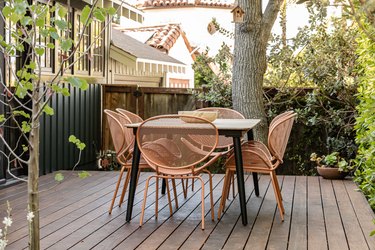The soil under stairs or a deck may be poor, rocky, or fertile, but weeds don't care — they'll still grow into an unsightly mess. Whether you choose to put mulch, gravel, or sand under a deck or stairs, each has its pros and cons. Among the many considerations when selecting a suitable soil covering are visual appeal, weed and pest control, and fire safety.
Gravel and Mulch
Video of the Day
Generally, the choice of materials to cover the bare soil under a deck and/or stairs include the various types of inorganic and organic mulch. Gravel, sand, and rubber are among the inorganic choices. Shredded wood, bark, straw, dried leaves, and pine needles are organic choices.
Video of the Day
Whether you select an inorganic or organic mulch, it's important to lay down a weed-blocking landscape fabric before adding 2 to 4 inches of mulch. In addition, though the weed cloth and mulch slows weed germination and growth in the soil, weed seeds can sprout and grow on top of the mulch, so it still requires maintenance and occasional weed pulling.
Fire and Defensive Space
Fire is a danger in nearly every community, whether rural or urban. Gravel is a better choice for under stairs and decks due to its inflammable nature. Rocks don't burn, so whether you choose pebbles, lava rock, river rock, decomposed granite, or crushed or pea gravel, it helps reduce the fire hazard around your home. Other ideas to cover dirt under a deck include flagstones or concrete pavers.
Noncombustible materials should be used within 5 feet of the home and any structures, including decks. In addition, gravel and/or pavers should be used along walkways and to divide plantings to help prevent a combustible path that leads to the stairs, deck, and house.
If you prefer something other than gravel, composted wood chips are less flammable than shredded bark, pine needles, dried leaves, and shredded rubber. The composted chips should be less than 3 inches in size and between 2 and 4 inches deep. Add 1/16- to 1/8-inch metal screening around the bottom of the deck to stop flying embers, which can smolder and ignite any organic or rubber materials.
Pest Control Around the Home
Gravel is also a better choice to help discourage pests, such as termites, and mold. Organic mulches provide shelter for ants and termites, and when it is piled too deeply against the foundation, the pests can travel over pesticide-treated soil and into the structure.
Damp organic mulches under stairs or decks also provide an ideal environment for molds, mushrooms, and other fungi. A layer of gravel helps water drain away from the structure and dries quickly, which helps prevent spore colonization.
Best Plants for Around a Deck
The best plants for around a deck vary according to your aesthetic, the available sun or shade, and the climate. Choose plants that thrive in your U.S. Department of Agriculture plant hardiness zone. Low-growing succulents, ground covers, and well-watered grass that is kept cut low are all visually appealing options; plant them 5 feet or more from the deck and house foundation.
Add vegetables, flowers, shrubs, and small trees as islands in a sea of gravel or mulch inside the 5- to 30-foot defensible space around the home. These add visual appeal around the house, deck, and stairs as you and your visitors approach your home without compromising fire safety. A drip-watering system puts water directly over the root ball, and chunky bark or gravel mulch keeps your plants green, flowering, and healthy while saving water. However, avoid planting resinous shrubs and trees, like junipers, pines, and other conifers.
Hanging plants and railing planters are an easy way to dress up the deck. Fuchsias, spider plants, petunias, begonias, string of pearls, and other trailing and vining plants add color and visual interest to your deck and stairs.
